5 Highlights of the SIDS Design Convention 2020
Interior Design & Decor5 minutes read
2195 views
2195 views
“2020 has been a strange year, a year of change for all of us. In a time like this, we just have to keep moving forward.”
Moving Forward - the theme for this year’s supposed Singapore Interior Design Awards (SIDA) 2020 Awards Presentation Ceremony, started by the Society of Interior Designers Singapore (SIDS) four years ago.
Due to COVID-19, the event was postponed twice before being combined with and reformed as the SIDS Design Convention 2020. Despite such a setback, the culmination of this event proved this theme’s point - to keep moving forward despite the challenges ahead.
A hybrid event and the first of its kind for SIDS, the Design Convention took place on 3 December 2020. It was physically held at the Roselle-Simpor Ballroom at Marina Bay Sands and streamed online live from the SIDS’s Facebook page, with over 250 online attendees from all over Asia.
In line with safety measures, only a maximum of 250 attendees was allowed at the physical event, with designated registration times and seating zones for safe distancing.

Screenshot from the event's Facebook Live Stream
Mr Tung Ching Yew, SIDA Chairman and SIDS Council Member, gave the opening address. He called for interior designers to reinvent and repivot themselves to face challenges brought about by COVID-19.
He also spoke about how attendees were still able to gather and celebrate local interior design talent despite the pandemic’s effect on initial plans, congratulating SIDA participants and thanking both the SIDS and event sponsors for persevering and bringing the event to life.
After the opening address, the SIDS Design Convention was defined through 5 major highlights.
1. 1st Keynote Speech
Ar. Ong Tze Boon
Group Executive Chairman, ONG&ONG
“The Real Virtual”
Mr Ong opened his speech with a quote from Steve Jobs: “It is not about the look. It’s about how it works.”
He advised attendees to think about the Why of their work: “What is what we do and what we sell. How is how we differentiate ourselves from our competitors. But Why is why we do what we do. People don’t buy what you do, they buy why you do it. Make ‘why’ the core of your design.”

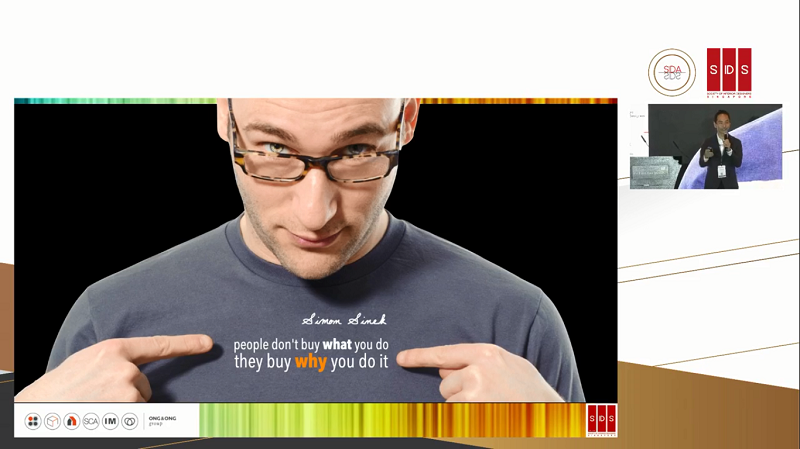
Screenshots from the event's Facebook Live Stream
He also points out the three needs of today’s millennial consumer market to be met: Personalisation, Immediacy, and Engagement. He cites Frank Bank from OCBC as an example of that design experience, where the bank is also a retail store and it allows users to personalise their cards.
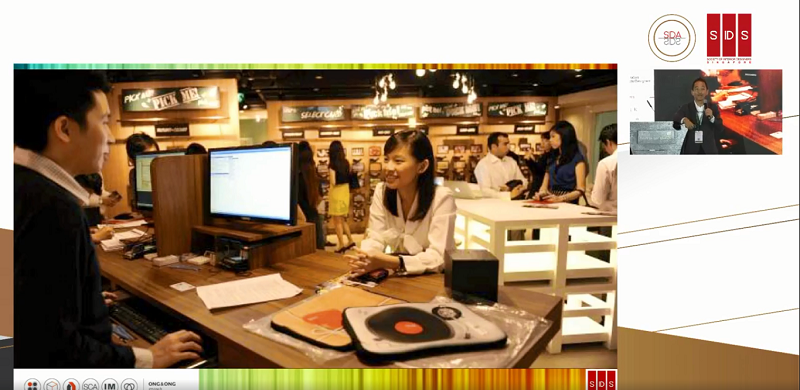

Screenshots from the event's Facebook Live Stream
Mr Ong also emphasized the need to design for a digital age, where it is about designing to meet the needs of the community with the three needs in mind. He explains that the digital world has extended beyond being an instrument of productivity and has now become an extension of the physical world.
Interior designers can take advantage of tools such as Virtual Reality, Augmented Reality, User Interface (UI), User Experience (UX), and QR Scanning to develop how and why they create spaces.
2. 2nd Keynote Speech
Prof. Carlos Banon
Director & Co-founder of AIRLAB Singapore / Assistant Professor of Architecture and Sustainable Design, Singapore University of Technology and Design
“AIRLAB Recent Works: Digital Design and 3D Printing for a Circular Economy”
Professor’s Banon’s presentation was a showcase of projects and technologies that his team at AIRLAB and SUTD have worked on.
Key points he brought up comprise how technology can make construction more eco-friendly by reducing carbon emissions and wastage of materials. “Use less, make more,” he said. He and his team had been working hard to make such technology possible by focusing on sustainable and recyclable building materials.
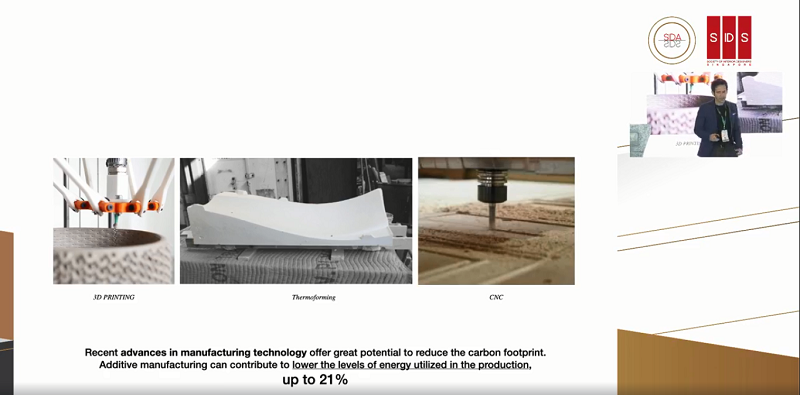
Screenshot from the event's Facebook Live Stream
One example of this was gathering waste materials like foam and cardboard and using 3D printing to convert them into new sustainable furniture. The team also managed to produce 3D printing filament from recycled materials, bamboo-based construction bars, and even plant-based plastic.
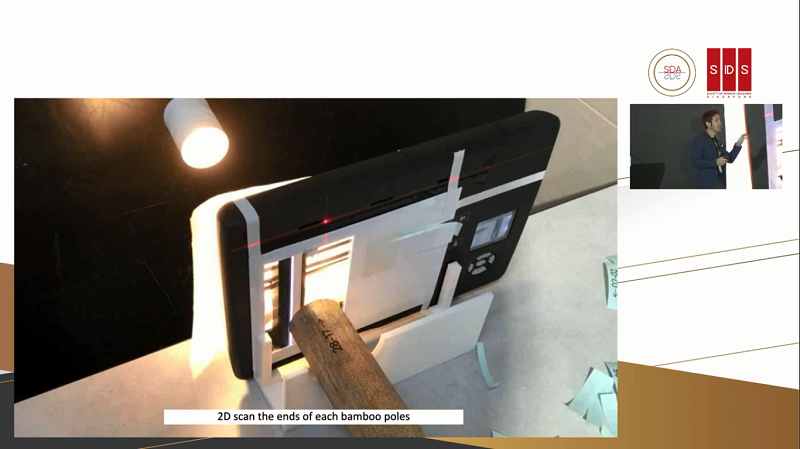
Screenshot from the event's Facebook Live Stream
They have put their specialised technology to work, constructing lean yet sturdy canopies and shelters for events and passersby. Two such projects were a green webbed canopy at Duxton Hill and a pavilion at Gardens By The Bay; thermal foaming was used for casting, creating sturdy structural nodes that were easy to assemble for durable, aesthetically pleasing results.
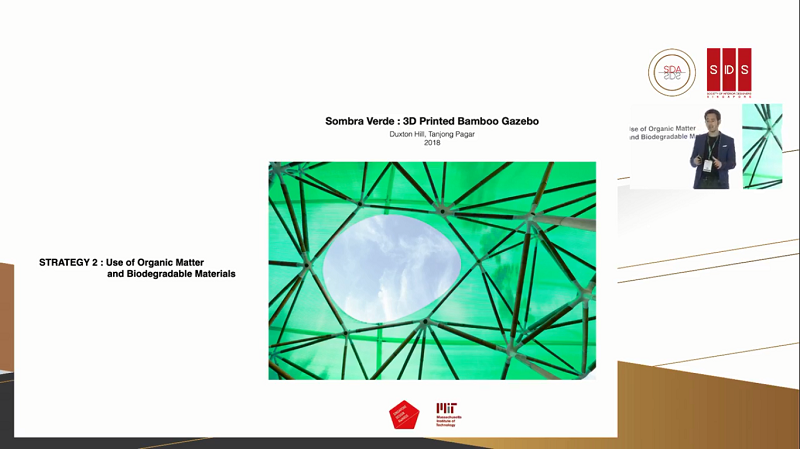
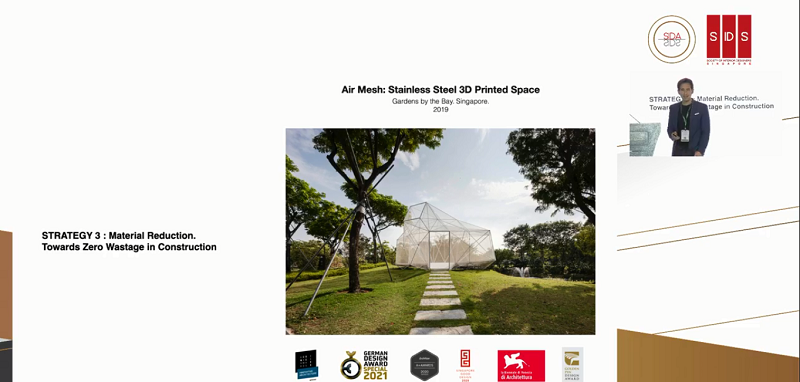
Screenshots from the event's Facebook Live Stream
This was also applied on a smaller scale to furniture, where AIRLAB fabricated a table with reflective bronze legs. The bronze legs were cast using the lab’s moulds and 3D printing. “Zero wastage, but unlimited imagination,” Professor Banon said.
3. SIDA 2020 Youth Category Awards Presentation
The Singapore Interior Design Awards introduced the Youth Category this year to allow interior design students to flaunt their skills and submit their most prized designs.
There were 50 entries, spanning across six local educational institutions. They were submitted to seven categories comprising subcategories for exhibition spaces, cultural and civic space, F&B spaces, hospitality spaces, residential spaces, retail spaces, and workspaces. Entries were assessed by an extensive line of judges with ample design experience.
Some winners were in physical attendance, while others joined in via the livestream. As per safe distancing measures, no physical contact was allowed except for receiving certificates, but winners were allowed to temporarily remove their masks for photo-taking.
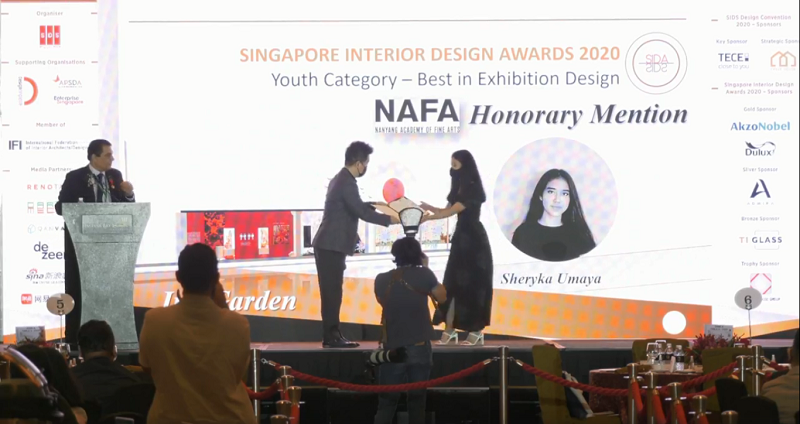

Screenshots from the event's Facebook Live Stream
Two of the SIDA judges, Mr Jack Liew and Mr Tan Szue Hann, as well as SIDA Chairperson and SIDS Vice-President Ms Kat Tan, presented the awards to the winners. Each of the seven categories had two honorary mentions, followed by Bronze, Silver, and Gold.
After the Youth Category winners were awarded, tokens of appreciation were also given to key sponsor TECE, strategic sponsor Smart Decor, and the forum panellists.
4. Third Speech
Mr Oscar Wezenbeek
Managing Director, Decorative Paints, South Asia and South East Asia (SESA)
“Embracing Change in 2021 With Brave Ground”
Attendees agreed with Mr Wezenbeek when he pointed out that colours can be used to heal a world hurt by a tumultuous year. He then introduced the AkzoNobel colour of 2021, Brave Grounds, a warm coffee-like colour meant to evoke comfort, safety, and warmth in an interior and turning it into a much-needed sanctuary in a post-pandemic age.
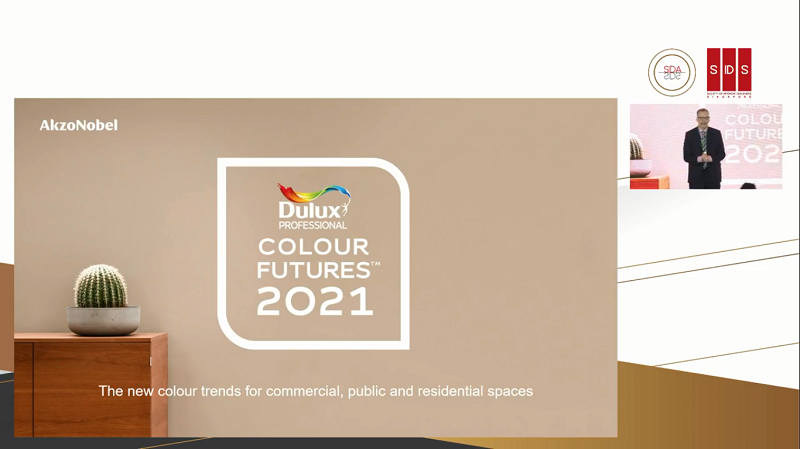
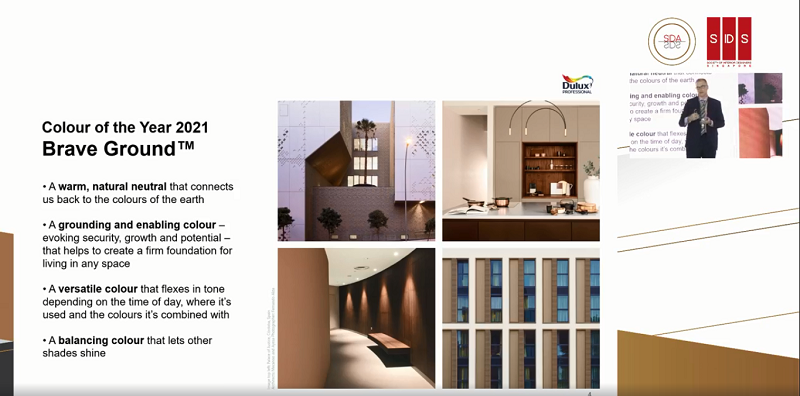
Screenshots from the event's Facebook Live Stream
Mr Wezenbeek also brought up the importance of understanding colour, reiterating that colours can mean different things depending on different cultures. He encouraged attendees to look at today’s trends to discern and pick the right colours for the right impact.
He also mentioned picking the right colour palettes to create a comforting space for family and loved ones, since colours affect one’s mental state and even attention span. He cites an education space as an example; the usage of reds and yellows plays a role in creating a non-threatening environment where one can be encouraged to learn.
Mr Wezenbeek also shared examples of where Brave Grounds can be used; this colour can be used in office and residential areas and healthcare facilities to create a comforting environment. If paired with plants, Brave Grounds can increase the ‘healing and comfort’ vibe in an interior.
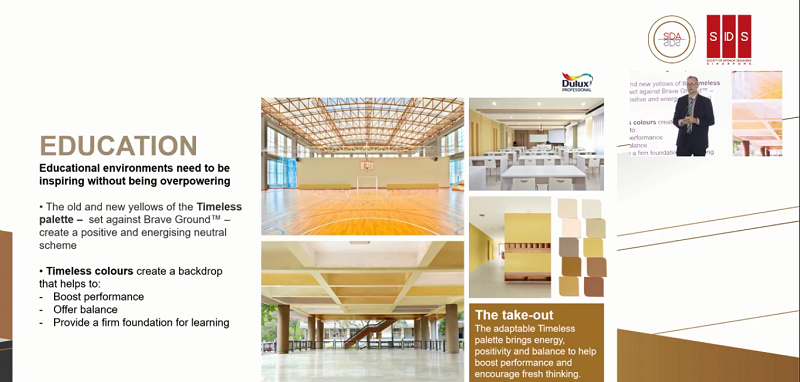
Screenshot from the event's Facebook Live Stream
Mr Wezenbeek encourages interior designers to not shy away from colours but use them instead to boost their projects. With the launch of Dulux Colour Sensors in Singapore, interior designers and customers alike can experiment with colours without the fear of making mistakes.
5. Panel Discussion
“Moving Forward”
The panel discussion was the last item of the Design Convention, where the three speakers sat down with Mr Mike Lim, Director of DP Design, to answer a few questions. The panel was moderated by Mr Rajah Shah, SIDS Council Member.
Questions presented were:
How do you see the interior design industry move with these changing patterns/digitalization (VR, AI, AR, etc)? Will technology completely take over?
Mr Lim feels that designers should try to capitalise on the ever-changing trends of today, urging them to prioritise value in their designs while taking advantage of digitisation. He points out that digitisation serves as a tool to help designers rethink their design process, and that they have a social responsibility in the way they design their spaces.
Mr Ong points out that COVID-19 has greatly impacted the design landscape and the ways things are done, with a growing need for mobility and a drastic shift in the office spaces of today. He asks ‘What is the office of tomorrow?’ and ponders the use of augmented and virtual realities for the offices of the future. This, he reiterates, hints at new ways to design spaces in the near future.
Mr Wezenbeek noted that while COVID-19 has made 2020 an uncertain year, he is optimistic that government support for building projects will come through. He also predicted that with working from home being in trend, there will be more opportunities for designers to upgrade homes and make them more comfortable to live and work in.
Professor Banon explained that designers need to be aware of how to work with data and how to integrate that data into their projects and processes. The design process of the future will have to balance between the immaterial, the digital, and the physical. The key? To remain relevant, to reinvent, and to consider both user interface and experience.

Panel discussion in progress. Screenshot from the event's Facebook Live Stream

Mr Mike Lim sharing during the forum. Screenshot from the event's Facebook Live Stream
Should I continue my education in design and go deeper, or broaden my education and diversify?
Professor Banon pointed out that design has evolved, especially with the science of materials and finding new ones. He encourages exploring and finding another educational track to go deeper, as experiences from different fields can be merged into design.
Mr Wezenbeek encourages attendees to follow their passion, as we are no longer ‘boxed in’ and there are a lot of opportunities available. However, there should no rushing but rather, comfortable pacing to develop value and set standards.
Mr Lim assures attendees that their design training is not wasted no matter what path is taken, as there is always a balance between science or art. What is important is to know how to solve problems and develop design thinking for any field.
Mr Ong brought up an analogy of two baskets to represent two different extremes of education. One basket represents forging out a new career path, while the other basket represents continuing the study of design while observing other subjects and then blending them together to create one’s own interpretation of design.
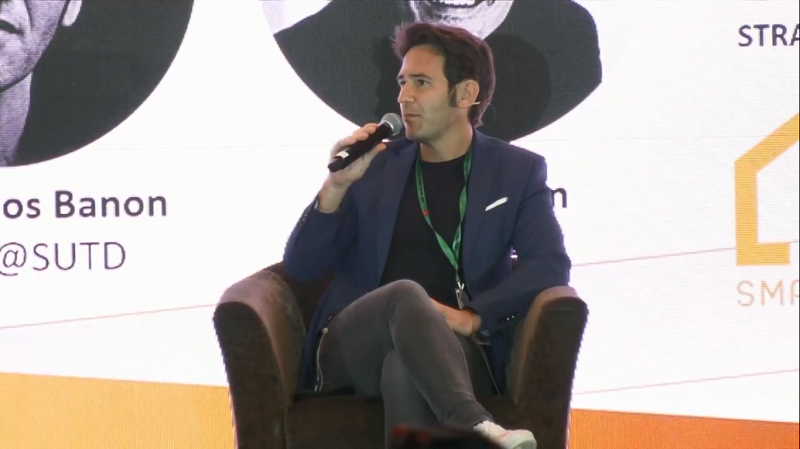
Professor Carlos Banon during the panel discussion. Screenshot from the event's Facebook Live Stream
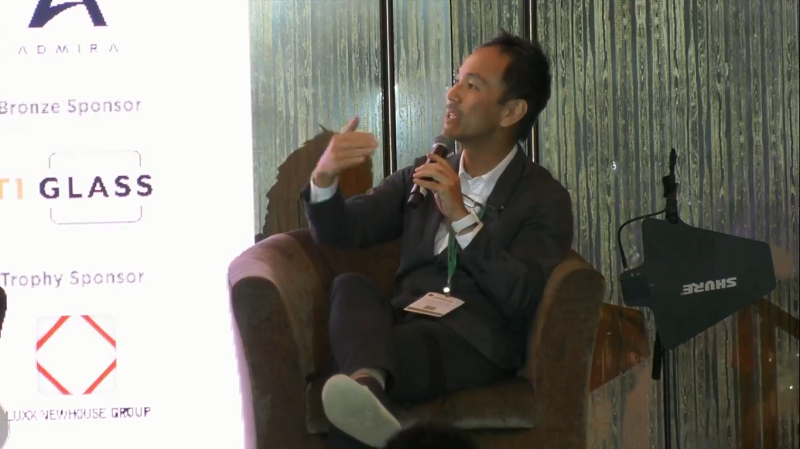
Ar. Ong Tze Boon during the panel discussion. Screenshot from the event's Facebook Live Stream
The panel discussion concluded the SIDS Design Convention 2020, leaving a 45-minute break before the commencement of the SIDA 2020 Awards Presentation Ceremony.
Watch this space for our highlights of the SIDA 2020 Awards Presentation Ceremony, which happened right after the SIDS Design Convention 2020.
The Facebook video stream of both events is available on the SIDS’s Facebook page.
Request for quotes and we'll match you with a selection of Interior Designers!
Previous
8 Interior Design Industry Trends To Look Forward To In 2021


 Sign Up with Google
Sign Up with Google

.jpg)


Thien Ha Bet (thabet) is considered as the house that owns the largest and most diverse online game store. There are all forms of sports betting, attractive card games, etc. with high winning rates. Including prizes up to 5 billion VND. Please visit https://thabet99.com/ to join